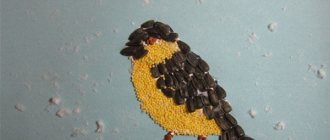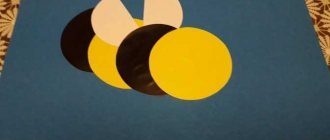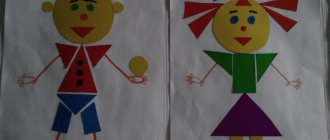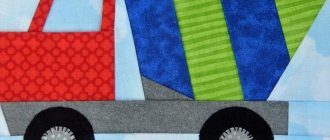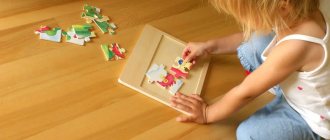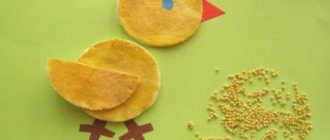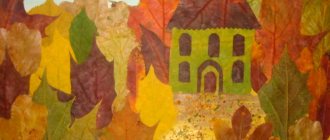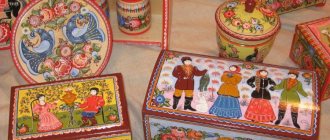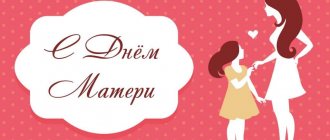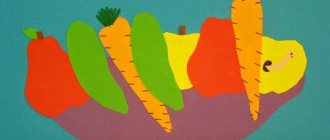Making crafts yourself is very useful for children, because it helps develop imagination and fine motor skills. Besides, spending time like this is always exciting and fun.
And to make spending time creating a beautiful, unique product even more interesting, connect with your baby - this way you both will get a lot of pleasant emotions and it won’t be boring.
Nuances in the technique
A kindergarten teacher is like a conductor. Selects a program, knows the musicians' parts, and reworks the score. Skillfully leads the entire orchestra so that the piece sounds harmonious.
The situation is similar with children: the teacher plans application topics; selects materials; draws up a lesson plan.
The end result is a vernissage for parents. All the kids are busy with collective creativity. So, let's look at each point step by step.
Plasticine fish
Probably everyone will like this method because of its simplicity and fun. And the end result will be a delicious goldfish. To create this underwater inhabitant you need:
- Make a base for a future application. To do this, use yellow and red plasticine;
- Next, you will need to roll out many small balls and flatten them into circles;
- The plasticine that you will have left after completing the previous steps will need to be rolled out into narrow strips;
- Next, you need to take a blue cardboard piece and mark the silhouette of a fish on it, after which you should surround its outline with circles of red shades;
- The inside of the body itself is surrounded by yellow circles. And the tail and fins are lined with thin stripes;
- An eye is also made from plasticine, which is then attached to the required location.
Once everything is ready, start decorating the background. Make seaweed, rocks, shells and other desired items from plasticine to complete the fish applique. Small pebbles or shells can be taken, even real ones, if such, of course, are available.
Use all your imagination, think through the whole composition. This way the product will look even more interesting and original. Once all the work is completed, you can place the craft in a prominent place so that it adds uniqueness to the overall atmosphere of the house and pleases the eye at any time.
Goals
Training sessions provide for the achievement of specific results.
In the case of applications with children (6-7 years old), the following is implied:
- Ability to use glue and different papers (thin, thick, colored, cardboard);
- At the moment of cutting, motor skills, eye and hand movements are involved. Children are instructed to cut out pre-selected fragments;
- Instilling a sense of composition;
- Development of skills of individual and collective activity;
- Development of speech abilities. During the work, the child needs to ask questions to the teacher if difficulties arise, and consult with his friends in the group;
- Expanding the boundaries of a child’s understanding of the animal world.
Volume applique
Despite the fact that the volumetric craft seems complicated, it is quite simple to make:
- Take a red or tan sheet of cardboard and draw a fish on it. Then cut it exactly along the contour. This is a blank for a future product;
- From double-sided paper in the colors you like, cut many narrow strips of the same size, and then glue the ends of each;
- All glued strips must be attached throughout the base, placing them evenly one after another. Only the head should remain free;
- Once the striping is complete, begin decorating the fish's head. Make a bunch of balls from scraps of napkins and paste them over the desired areas. The eyes and mouth are made in the same way.
This product looks quite unusual and unique.
Materials
When choosing work materials, consider your child’s current skills.
Conducting a lesson
When planning a lesson, you need to take into account the speed of the children’s work, as well as the time allotted for the lesson. In the preparatory group, the recommended duration of continuous educational activity (CED) is 30 minutes. The logical blocks of the lesson can be as follows:
- organizational stage (1 minute): children get into a working mood, greet the teacher;
- motivational stage (5–7 minutes): children are offered an interesting story, a plot that awakens interest in the topic of the lesson;
- explanation stage (5–7 minutes): the teacher explains to the children exactly how to perform the application;
- dynamic pause (1 minute): light warm-up;
- independent work (15 minutes): with the help of a teacher, children complete the application;
- summing up (3–5 minutes): organizing an exhibition of children's works, discussing the results.
Motivational start of the lesson
A significant part of the success of the lesson depends on the interest of the children. For motivation you can use:
- fairy tales and cartoons about fish, based on which children will make applications (“Finding Nemo”, “Goldfish”, “The Little Mermaid”, etc.);
- an aquarium in a living corner: for example, the teacher tells the children that their fish is sad because it doesn’t have enough friends. Pupils can help her if they make an applique with a lucky fish in a circle of relatives;
- short videos about wildlife, which tell about the amazing kingdom of fish;
- riddles about fish, for example: “Parents and children have all their clothes made of coins” (answer: fish).
Table: example of a lesson summary on the topic “Goldfish in an aquarium”
| Purpose of the lesson | Creating conditions for expanding children’s understanding of aquarium fish, for children to complete a plot application on the theme “Goldfish in an Aquarium” using existing skills and abilities in working with paints and scissors. |
| Tasks |
|
| Methods and techniques | A visual demonstration of working methods, a story, practical activities of children, questions for children. |
| Materials | White A4 cardboard, yellow and blue gouache, sippy cup, bristle brush No. 24, paper napkins for brush dipping, scissors, glue stick, strips of green colored paper, squares of yellow colored paper, illustration of a goldfish. |
| Preliminary work | Reading the fairy tale by A. S. Pushkin “About the Fisherman and the Fish”, designing a fish using the origami technique. |
| Motivational start | The teacher offers to guess the riddle: She always lives in the water, and she swims all day long. It wears fins on its back. They are beautiful and light. (answer: fish) Educator: that’s right, it’s a fish. Fish, guys, are animals whose bodies are covered with scales. Fins help to move in the water, and with the help of gills, fish breathe oxygen. The tail serves as a rudder and is the engine of the fish. Nowadays, people love to keep fish in their homes. Educator: Guys, where can a fish live in the house? (answer: in an aquarium) The teacher shows the children an empty aquarium. Educator: What shape is this aquarium? (children's answers). Guys, it’s boring to look at an empty aquarium, what needs to be done to get a fish to live in it? (children's answers). Yes, the fish needs water, algae, sand and pebbles. Goldfish are one of the most beautiful and popular aquarium fish. The teacher, raising his hand and bending it horizontally in front of his chest, shows wave-like movements with his palm, inviting the children to start working: swim fish, swim gold. |
| Explanation stage | The teacher suggests cutting out a round aquarium from a sheet of white cardboard along the drawn outline. And together with the children he discusses the possibility of filling the aquarium with water and sand at the bottom: the children come to the conclusion that the easiest way to do this is with paints (sand - yellow, water - blue). Make the fish using the origami technique, and cut the seaweed from green paper. |
| Independent work stage |
|
| Dynamic pause (performed in the middle of independent work) | “Fish” The fish swims in the water, the fish has fun playing. (with their palms folded together, children depict how a fish swims) Fish, fish, mischief! (they shake their finger) We want to catch you. (they slowly bring their palms together) The fish arched its back, (with palms folded together they depict how the fish swims) She took a bread crumb. (make a grasping movement with both hands) The fish waved its tail, the fish quickly swam away. ("floating" again) |
| Final part | At the end of the lesson, make an exhibition of works. Educator: guys, do you like our goldfish? (children's answers) What was the most interesting or difficult thing in your work? (children's answers). Well done to all of you, now you will have your own goldfish at home. |
| Source | Vladimirova L. https://www.maam.ru/detskijsad/konspekt-nod-po-aplikaci-v-podgotovitelnoi-grupe-na-temu-zolotaja-rybka-v-akvariume.html |
Depending on the speed of work, the child can make either one or several fish in his aquarium
Gallery: examples of finished works
Fish can also be made from painted pebbles, complemented by fins and tails made of feathers. Colored paper is suitable for making fish using the origami technique. Small round fish can be made from plastic bottle caps.
From individual children's works you can create a whole large aquarium for the entire group Bright paper baskets will not only add volume to the fish, but are also suitable for simulating scales A tail made of garlands will create the effect of the fish moving
Fish can be made from seashells, adding plastic or plasticine eyes and fins
To create bright and beautiful scales, you can use shiny paper or candy wrappers
From natural materials, such as dried leaves and herbs, you can create an entire underwater world. Pasta is suitable for simulating scales on the body of a fish. Not only the fish itself, but also algae and pebbles can be made from plasticine. A stylish and at the same time laconic composition can be made from straw
Felt is an incredibly convenient material for cutting out applique details. You can use old CDs as the basis for the body of the fish.
Video: three-dimensional application “Fish” in various techniques
Video: applique made of colored paper “Fish”
Video: origami fish
Gallery: templates for applications
Using this template, the fins are cut out in an arc and bent to add volume. To add volume, we make cuts along the tail of fish and crabs, roll them into a cone and fix them with glue. A simple template, convenient for transferring to paper or fabric. In addition to fish, children can use the template to fill the aquarium with other sea creatures. There are There are various options for creating a fish using the origami technique, and the simplest of them are suitable for older preschoolers. In some cases, shells can be drawn according to a template on the background for applique. Not only fish, but also other sea inhabitants can be placed in the aquarium
The result of a successfully conducted lesson on applique aquarium fish will be a beautifully designed stand with works, as well as satisfied children who have learned a lot about the world of underwater inhabitants and about techniques for working with different materials.
Paper
Children become familiar with this material even before kindergarten. Parents read fairy tales to their child, turning over the pages of a beautiful book. Teach the child how to use scissors correctly.
They color coloring books together. If you don’t have enough time to collect materials, the paper option is the most convenient. In preparatory groups, some children achieve impressive results by making appliqué from plain paper.
Note! Scientists studying the psychology of children (ages 1 to 6 years) say: paper cutting skills with scissors should be taught from the age of 1.5-2 years. In this way, concentration is developed, motor skills are trained, and logic develops.
Goldfish applique
Everyone knows that goldfish make wishes come true. You can use various materials to make it; several information catalogs are available on the Internet. It’s both a pleasure to make such a craft and to give it as a gift.
You will need: cardboard, sheets of yellow, white, black, pink and orange (preferably glossy), glue, scissors.
We make a circle out of cardboard, you can use any template, a compass, and even a saucer can be traced. Also cut 2 circles from the yellow and orange sheet. Glue the yellow circle onto the cardboard shape.
It is necessary to cut off a quarter of the orange part in a semicircle. This will be the torso. Glue an orange one onto the yellow circle, the goldfish will have a yellow head and an orange body.
Next, cut out the tail and fins from the yellow sheet, you can use the template. Cut out the eyes from a white sheet, and the pupils from a black sheet and glue them onto the fish. To decorate, cut out small triangles from yellow or gold paper and glue them onto the orange body of the fish.
Textile
Can be used partially, especially as large elements for the main product. For example, it could be water. Of course, children will not be able to cut out the material themselves. It is difficult to cut straight, the material crumbles.
Requires some dexterity. Parents or a teacher can help with this by making large blanks and templates in advance for the whole group.
The child can be assigned homework - cutting something out of fabric under the supervision of the parents.
Geometric applique
This type of fish applique in an aquarium is perfect for kids, both younger and middle groups. During the creation process, they will not only have fun creating the product, but will also become familiar with a variety of shapes. Manufacturing consists of several steps:
- The first thing you need to do is find the right shades. The fish can be made in absolutely any color, and the background should be blue or blue.
- Four large circles are cut out of multi-colored paper for the bodies of the fish, four medium ones for the tails and a couple of small ones for the fins;
- Each circle is folded in half, and then any two semicircles of different colors are combined into one fish. After this, you can glue the remaining parts: tails and fins;
- Eyes and scales are drawn with a felt-tip pen.
You can add seaweed to the background by cutting strips of different lengths in green shades. It will be great to draw something using bright markers.
Natural materials
Chestnuts, leaves, pebbles, etc. are used. The child should have such items in limited quantities. Otherwise, the baby will lose attention to the main work.
The young worker needs to glue the sea pebbles or seaweed evenly. And follow one path in composing a composition.
Fabric applique
For such a composition you will need fabric of different colors and templates according to which the parts will be cut out. Each part is cut out very carefully with scissors, because you need to work with such material very carefully.
When all the elements are cut out, glue them as planned onto a cardboard sheet or fabric base.
To diversify the composition, it’s great to glue sequins, rhinestones, small beads and similar little things.
Decorative elements
Such things can be beads, sequins or rhinestones. Such items must be provided to the group in limited quantities. Otherwise, the problem described in the previous paragraph will arise.
In this way, the child develops his own taste and sense of proportion. The baby will be able to find a suitable place for the decorative detail.
Hanging fish
This original craft can decorate a group in a kindergarten, a classroom at school or a room. You can conduct a master class on this craft, which will show children’s imagination not only in production, but also in decorating the space.
You will need: a ruler, scissors, a pen with black paste, a pencil, glue, a set of sheets of yellow, green, orange, red, white, thread.
For the details of the fish, you need to take paper. For example: from a yellow piece of paper, cut out a blank for the body in the form of an elongated oval with tapered ends. The tail can also be cut from an orange sheet, but smaller in size than the body.
The mouth is made from red stripes, and from the green one, make a blank for the fins, also in stripes. The eyes are prepared from a white piece of paper, the pupil is drawn with a pencil or black pen. The part for the body must be folded in half and the ends glued together; the figure should be in the shape of a droplet.
Glue the orange blanks for the ponytail together as well. Glue the tail to the body, with the tapered ends facing each other. Strips of red and green colors must be rolled into tubes and glued together.
Two red tubes are glued to the front of the fish. The sponges are ready. Glue green tubes on top and bottom of the body - these are fins. Then the eye blanks are glued.
It is better to make several colorful fish in this way. Attach these figures to strings and hang them up.
Technique
A beautiful applique depends on the amount of materials and technique of application. Children aged 6-7 years are probably familiar with the underwater world. They know what aquariums and fish look like; drew underwater inhabitants or painted them. Therefore, the work can be slightly diversified. Next, we learn how to do it ourselves, introducing various materials.
- Use volumetric elements made of paper. These could be fish or other creatures from the underwater kingdom. The origami technique is applicable here.
- Small parts made of plasticine. For example, a baby can mold fry. If a child has already come into contact with this material before, it will be easy for him to interact with it purposefully in the future.
- For fish scales, a mosaic of cereals (buckwheat, semolina or millet) is used.
- Ribbon applique elements are used, made using the round dance method - they are simultaneously cut out and tied together.
- For collages, pictures from magazines or stickers are used.
Volumetric fish
You will need: a blue sheet of paper, multi-colored corrugated paper, a toothpick, glue, fish figurines (you can draw, print or take them from coloring books), scissors.
Cut the corrugated paper into small squares. Screw each square onto a toothpick, the work is painstaking. Place the blank figures on the blue piece of paper.
Cover each part of the fish’s body with twisted squares, and then fill the rest of the space of the figure tightly. Then you can add a diverse underwater world to the sheet: algae, pebbles from corrugated squares.
You can also paste over the background with different shades from blue to light blue of the corrugated sheet.
In the same way you can make one large fish. Such applications turn out amazingly beautiful.
Individual approach to each child
During preschool preparation, the educational process requires an individual approach. If one child is diligent, you should entrust him with cutting out elements from cardboard paper.
But entrust a real fidget with gluing the details of the composition. This way, the noisy child is involved in a group activity and will not get bored while cutting out appliqués for a long time.
The formation of work fronts depends on several aspects:
- Temperament. Don’t push a slow baby by motivating him with the words “Everything has already been done!”
- Preparation. Not every child and their parents practice appliqué or other exciting activities at home. Therefore, not every child in the group will master certain tasks.
- Initiative. Don’t contradict your child if he wants to draw fish instead of the sea.
Aquarium fish
This task is for the older group of kids, but younger children can also cope with it with the help of adults.
You will need: a white piece of paper or cardboard, a set of multi-colored double-sided paper, glue, yellow and blue paints, a sponge (you can take it for dishes), scissors, ready-made self-adhesive eyes (sold in craft stores).
You can take cardboard or a white piece of paper and paint the background blue and yellow. This way you can differentiate between the sandy bottom and the water in the aquarium. Children can do this entire procedure with a sponge. They will like this kind of work. Next comes the work of preparing the blanks.
Fish can be cut out of colored paper according to a prepared template or sketches. Also do everything with algae, cutting them out of a green leaf, corals from brown or pink, and pebbles can be multi-colored.
To make the composition sparkle with bright colors, you need to distribute the details on the dried cardboard.
Such a fun craft can be placed in any room, and it will cheer up both children and adults.
About motivation
There is one famous saying: “Whatever you call a ship, that’s how it will sail.” Children's motivation works in a similar way. The way you motivate a child is how he works.
In this case, several methods of effective motivation are used.
- Conversation. An effective method to set up for productive activities. For example, ask some leading questions: Where do the fish live? Where will we place them - at home or in a group? Speak to children on behalf of animals by putting a doll of some animal on your hand.
- Puzzles. They intrigue and develop their way of thinking.
- Images. Children need a clear example to understand. So that your child can make a fish, show a photo of the fish applique.
- Presentation. Show a short slide video while talking about the underwater world.
- Stories. Talk about a goldfish to encourage kids to create a similar prototype. This is a great way to boost their motivation levels.
Accordion fish
This accordion applique is easy to make, but the result is very impressive.
You will need: colored paper sheets, glue, scissors, white and black paper, blue cardboard.
Cut a wide strip. This will be the torso. We bend the workpiece horizontally like an accordion, then fold it in half and the fish will be in the form of a fan. We glue the fold so that the part holds better. We straighten the fan and glue it onto blue cardboard.
We do the same from another colored paper - this will be the tail. We glue it to the body with the narrow end to the wide part of the fish’s body. The applique is voluminous due to the fan-shaped fish.
The fin can be cut out of paper in the form of a quarter circle and glued in the middle closer to the head. We cut out the eyes in a circle from a white sheet, and the pupil from a black one. We fasten the parts together and then onto the applique.
These fish can be made in many different colors and sizes.
Make a plan
No more than half an hour is allocated for the lesson.
Each stage of training is divided into several aspects:
- Motivational process - 5 minutes.
- Explanation of the main task - 3 minutes.
- Work with blanks - 10 minutes.
- Three minute break.
- Continuation of work activity - 5 minutes.
- Reflection - 5 minutes.
Application from paper strips
This fish craft is no less beautiful and is perfect for kids. To construct one, you will need to cut out a blank that serves as a base from a sheet of multi-colored cardboard. One of them - a semicircle - is glued to the paper.
The remaining material must be cut into a bunch of thin strips. All of them are glued in half and then attached to the product blank. The second blank, which is a smaller semicircle, will become the fin. Eyes and other necessary details are drawn with a felt-tip pen.
After all the above steps have been completed, you can give free rein to your imagination and come up with something of your own, original. This way your fish will turn out to be even more interesting and will not be like any other.


